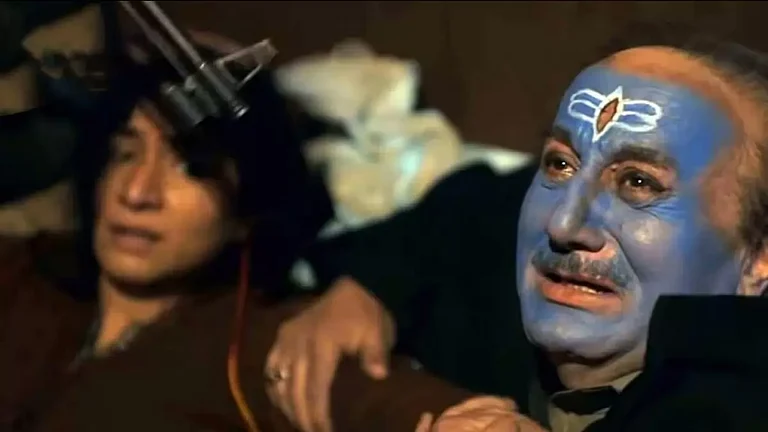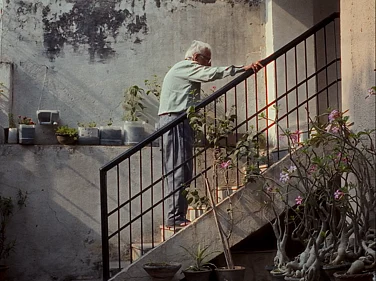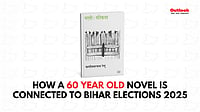“Your iconic song about the irreverence and exuberance of youth Masti ki Pathshala is a classic. The film (Rang De Basanti) upheld political realities through a disarming story of young people coming-of-age. It was a breakthrough for Indian cinema both for its critique of the state and the sleight of hand by which it was delivered”, wrote Ashvin Kumar, director of No Fathers in Kashmir, in his open letter to Central Board of Film Certification (CBFC) Chairperson Prasoon Joshi.
No Fathers in Kashmir may have been one of the last films to come out of the valley. The film was released in April 2019 but not before a long battle with the CBFC. The film was awarded Adult 'A' certificate, eight months after it was submitted, way beyond the time allotted for providing or refusing a certificate by the CBFC.
The film raised important questions as the child protagonists Noor and Majid searched for their disappeared fathers. Noor gets caught by the Armed Forces, Majid has the opportunity to escape but he comes back for Noor. In a turn of events, Noor is left because of her British Passport but Majid remains arrested.
After a second screening, the film secured a U/A Certificate following edits and disclaimers. One of the edits to be made was “reduction of the scenes regarding the ransacking of the house and repeated stamping of the mobile phone with showing the flashbacks of Noor’s life and memories being stamped out”. The dialogue “In the 90s every camp had an interrogation room sometimes they’d go too far, and they’d have to bury the bodies quickly” was also cut. These edited scenes and dialogues show an unfavorable side of the armed forces, moving away from the narrative of state actors as protectors of the valley that Bollywood has tried so hard to curate.
In the 1960s, Kashmir was the paradise of Hindi language films. Jawaharlal Nehru believed that in Kashmir “loveliness reigns and an enchantment steals over the senses.” Films like Junglee (1961), Kashmir ki Kali (1964), Jab Jab Phool Khile (1965), Phir Wohi Dil Laya Hu (1963), and Aarzoo (1965) captured the valley's fauna and flora. These films integrated Kashmir into the Indian masses' Imagined Communities, depicting scenic beauty while overshadowing authoritative hegemonic practices and fetishizing Kashmiri attributes and language. The films ignored the trauma, violence, and humiliation that shaped Kashmiris' lives, presenting them through the lens of outsiders.
Around the same time, the Kashmir film industry also made two feature films: Mainz Raat (1964), the first Kashmiri language film and President’s Award winner, and Shayar-e-Kashmir Mehjoor (1972), about the poet Mehjoor.
In the 1990s, filmmakers distanced themselves from Kashmir due to militancy. Mani Ratnam's Roja (1992) was the first to address ongoing political issues, using other locations to recreate the valley. The film, awarded for National Integration, portrayed the state actors as righteous and protectors of the civilians. The 2002 film Mission Kashmir may have taken a deeper look at militancy in Kashmir by incorporating a back story to Altaaf (Hrithik Roshan), a militant but sticks to the state actors as protectors' narrative.
Meanwhile the narratives emerging from Kashmir were/are controlled by the CBFC through different forms of censorship. The English-Kashmiri documentary Waiting (2005) by Atul Gupta was banned by the CBFC. The documentary is a combination of interviews by women whose husbands have disappeared or as they believe ‘picked up’ by the Armed Forces. The focal point of the documentary, however, is not the adults but rather the children who are pleading for the fathers to be returned to them. Among such children, is the young girl who wished to ask the former Prime Minister Atal Bihari Vajpayee during his visit in Kashmir to return her father.

The reason provided by the CBFC was that the complicated circumstances have not been dealt with an extensive and detailed manner. In decisions such as this where the applicant of the certificate is not content by the decision (or in a case of difference of opinion among the Examination Committee), the Chairperson has to refer the film to the Revising Committee. The Revising Committee also happened to refuse the certificate to Waiting. The film was made over a period of two years. Contrastingly, Shoojit Sircar’s Yahaan (2005), depicting a more favorable view of the army, was released and successful, illustrating the CBFC's preference for narratives that align with governmental perspectives.
The release of Fanaa in 2006 created a new binary for the Kashmiri identity. The previous binary of exotic beauty versus terror and fear was then replaced with good Kashmiri one whose allegiance is with the state and bad Kashmiri who functions against it. Zooni (Kajol) is patriotic and nationalistic dancing on Des Rangeela, contrasting with Rehan (Aamir Khan), who challenges the state and is a militant. Years later, in Raazi (2019), Sehmat says Watan Ke Aage Kuch Nehi, Khud Bhi Nehi (Nothing comes before the country, not even yourself!) revisiting this good Kashmiri versus Bad Kashmiri binary. Films released under two different governments depict the state's efforts to silence Kashmiris and suppress the valley's voices.
Five years after Waiting (2005), the second film to be released around the disappeared people was the Kashmiri feature film Harud (2010) by actor-director Aamir Bashir. The film has a non-linear narrative providing space to the surroundings that serve as a character in the plot. This includes military checkpoint sequences; close up shot of combat boots and the armed forces running making the distinct noise of the boots present in day-to-day life. It follows a J&K Traffic Police Officer’s family and their efforts to cope with the disappearance of their eldest son.
Harud was initially denied certification by the examination committee of the CBFC and was sent to the reviewing committee for the approval of screening of the film. The film was finally awarded a U/A Certificate but three weeks prior to the release of the film, the CBFC informed the director that the film needs to be reviewed again because of a shot of a wall which reads 'Azaadi' (Independence).

This shot was noticed during the trailer of the film being played at theatres. The CBFC wanted to send the film to the revising committee, but Aamir Bashir decided to not run the trailers instead. “As taxpayers, it is absurd. Once they okay the film, how can they do this? I have decided not to run the trailer as a matter of principle. There is so much work pending with the film slated for a July 27 release. I can’t make changes to what they have already seen and approved”, said Aamir Bashir in an interview. “For a short-budget film, this is an additional cost”, a spokesperson further added.
In both Waiting (2005) and Harud (2010), the armed forces have been depicted as perpetrators rather than protectors. The disruption to the circulation of the film then seems to be a method to keep the narrative of Kashmir’s conflict as causal of its inhabitants and not state actors. The institutionalisation of censorship first happened during British colonialism, primarily during the 1920s. The institute controlled how things are portrayed or expressed. Post independence, Article 19 i.e. Freedom of Speech and Expression juxtaposed the institute of censorship, but the national imagery reigned superior; CBFC continuing the control of circulation and distribution of films.
An Adult ‘A’ Certification by the CBFC curtails the exhibition of the film on television networks. A film certified ‘A’ cannot be screened on television channels unless it reapplies to the CBFC in order to get a ‘U’ certificate. At the same time, the certificate disables the opportunity to find distributors of the film. The documentary Inshallah, Football (2010) is exemplary of the method of Adult (A) certificate used to silence voices.
Juan Marcos Troia, the FIFA and Argentinean national and FIFA football coach had selected Basha among some of the best players in India for an exchange program for training in football in Santos FC, Brazil. However, Basha was the son of Bashir, who surrendered himself as a militant. He was denied a Passport by the Indian Government due to his father’s history. After interventions from the then Chief Minister Omar Abdullah, his passport finally came through.
The reason provided for the Adult Certificate of Inshallah, Football was characters talking about graphic details of physical and mental torture they had to undergo. The film's theme was regarded mature, and some dialogues psychologically damaging to non-adult audiences. The criteria in the first instance are problematic in itself since it regulates and controls freedom of speech and expression.
However, when this criterion applies to Inshallah, Football’s theme, can we overlook the film's powerful role in encouraging the audience to question authority as a reason for curtailing its distribution?
Since the abrogation of Article 370 in 2019, movies like The Kashmir Files (2022) and Article 370 (2024) have released, stripping Kashmir of its cultural and historical context, and erasing its people's identities. The director of The Kashmir Files Vivek Agnihotri is also a Censor Board Member, despite receiving criticism for spreading Islamophobia the film went on to earn 300 crores. Article 370, on the other hand, does away with subtlety, fully supporting the state’s narrative of revokement of Article 370 as necessary. The film was also made tax free in Madhya Pradesh and Chhattisgarh. With no comments from the CBFC and tax concession, the distribution of the films becomes easier making it more accessible to the audience.
Conversely, Bilal A Jan's 2012 Kashmiri documentary Ocean of Tears (2012), detailing the Kunan Poshpora Mass Rape (1991), the Shopian Rape and Murder (2009), and the Gang-rape and Murder of Ashmal (2002), faced an unofficial ban. In the documentary, the night of 23 of February 1991 was recollected by the victims of the mass rape, 150 soldiers had allegedly barged into their houses and raped them, four among the victims succumbed to their injuries and many among the victims till day were paying thousands of rupees for their treatment. Allegedly, only women and children were inside the houses when the crackdown began, old men were left in the snow whereas the youngsters were taken to torture centres.
The documentary was funded by the Public Service and Broadcasting Trust (PSBT), an organisation financed by the Union Ministry of Information and Broadcasting. Despite the sanctioning of the government, the censorship certificate was granted when the documentary originally 78-minutes was cut short to 26 minutes. The documentary was to be screened at the Kashmir University in 2012 but the screening was cancelled by the University allegedly on the order of the state government, the police had also arrived just before the screening of the documentary took place. Similarly, in 2013 when the documentary was about to be played, the screening was called off on the premise of a call from supposedly the home ministry. It was again set to be a part an international film festival. During the screening of the documentary, RSS activists interrupted the screening and disrupted the venue; they attempted to destroy the projector.
The difference in treatment of films emerging from the valley versus the films produced from an outsider perspective is stark. Ocean of Tears was government sanctioned but did not follow the narrative of the state compared to The Kashmir Files and Article 370. Films emerging from Kashmir happen to trace similar themes i.e. the abuse of power on the hands of Armed Forces, disappearance of people, helplessness among citizens. The CBFC’s regulation of Kashmiri films reveals a deliberate strategy to control and shape public perception. By banning films, enforcing adult certifications, demanding scene deletions, and imposing unofficial bans, the CBFC maintains a particular image of the nation-state, silencing Kashmiri narratives that challenge the status quo.





























